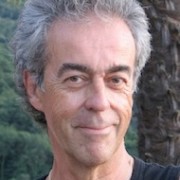Born in the middle of Europe, on the Western side but close to the Eastern block, I was a child aware of frontiers (I lived on a river border which I often crossed to conquer foreign land), migrations, exiles and cultural axes. There had been a Russian migrant wave, a Hungarian one and later a Czech one, plus sporadic whitecaps of other nationalities. My classmates came from all over the world, connected with seasonal workers, political refugees and international organizations. The waves of migration brought artisans with their traditions and techniques, a professional population in construction sites and hostelry, and all were concerned with cultural adaptation.
At age eight, I contracted polio with encephalitis and was eventually treated during rehabilitation by a woman therapist who was a dancer and a musician. She recommended that I start playing guitar as a way to recover the full use of my left hand - and I have never stopped. Older cousins of mine introduced me to Mississippi Blues, an early initiation to my interest in that unique and culturally distinctive region of the USA. Geneva hosted the American Folk Blues Festival and during my college years. I played in various rock bands…which led me to travel a lot in Europe, noticing the variations in languages, set designs and scenic strategies, body expression and social performances, including rituals, music, dance and theatre.
My grandfather was a country doctor and a number of my uncles and cousins were doctors too; most of them surgeons. They influenced me in choosing medical studies, with the intention of becoming a war traumatologist and a reconstructive surgeon. Either that career as a surgeon or a theater director, a filmmaker, or an architect and a set designer.
This was the Vietnam War era and many students came to Geneva from both South Vietnam and the USA. Then came the refugees fleeing Communist aggression in Eastern Europe, all of which created the Geneva of today, where 45% of the population is made up of foreigners from countries all over the world. Migration waves ensured a permanent blending and renewal of nations, including Switzerland’s population: Turkey, the Kurdistan territories, Angola, Zaire, Chile, Argentina, Iran and Ethiopia…and still counting.
I made the decision to undertake a university program of studies combining medicine and cultural anthropology. My first move was to spend time abroad during my studies. I went to Montreal from 1972 to 1973 and worked at the McGill Children Hospital. There I encountered a Native American family that was losing their third child to tuberculosis, which taught me to always investigate broadly when there are so many parameters to consider about health and illness, including, religion, fatalism and other factors. It took me a lot of effort to finally understand and speak the French of Québec, even though French is my mother tongue.
I met Mônica Koechli, a third generation Brazilian from Salvador, Bahia, the daughter of a cocoa exporter, whose own father had started working in textiles in the Nordeste (Northeast of Brazil). This connection facilitated my ethnological fieldwork in Bahia, focusing on religious syncretism in relation to mental health. My academic director was the cultural psychiatrist Álvaro Rubim de Pinho at the Universidade Federal da Bahia. He was an academic and honorary collaborator of Opô Afonjá candomblé terreiro (the African Brazilian Yoruba religious tradition, organized in compounds). Through Mônica and her family I also met the visual artist Carybé, who has remained my main reference in drawing techniques. We traveled through the Amazon area and the Northern states of Brazil, the Nordeste and the East, to expand the fieldwork experience.
We then moved to New Orleans, Louisiana, where Mônica registered in sociology and education and I in anthropology and sociology, at Tulane University. Cultural anthropology was my option and I enjoyed the teaching in human sciences such as that of anthropologist Arden King, a traveler and a humanist with contagious enthusiasm for his field. I continued training in psychiatry with Arthur Epstein and in epidemiology with sociologist William Bertrand who was incredibly supportive. Mônica and I became involved in the cultural and performance life of New Orleans through the musical network, visual arts, literature and food, from fishing and hunting practices to cooking. We traveled throughout Louisiana to meet the French- speaking Cajuns and Creoles, eventually adding more repertoire and skills in playing bottleneck, slide and lap steel guitars.
When we returned to Geneva in 1982, Gaston Garrone, the head of the Department of Psychiatry at Geneva University, gave me the opportunity to pioneer cultural psychiatry (ethnopsychiatrie) in Switzerland. The psychoanalyst Paul Parin had already taken a step in this direction in Zurich. The relevant option then was to launch and develop the Migration and Health axis around which I organized clinical activities, teaching and research. I also became a member of SSPC and WPA-TPS, so I could keep up connections with others working in this field. I was encouraged to take these steps after discussing my interests and activities in cultural psychiatry with Rachid Bennegadi and Richard Rechtman, who I met at the WPA congress in Athens, in 1988.
In 1992, following Gaston Garrone’s death, the Department of Psychiatry at Geneva University terminated what it considered my
maverick approaches. I needed a “working family” and found it in the form of an experimental theater group and international network of people involved in intercultural theater and performance studies. After having organized workshops for the Theatre in English in Geneva, I was introduced to the work of the Odin Teatret from Denmark, whose founder and director is Eugenio Barba. Since the 1970s, Barba has worked at intercultural theater, designing exercises and rehearsal practices as well as organizing a body learning system called Theater Anthropology. Apart from the work at the Odin Theater, he has also created a network, the International School of Theater Anthropology (ISTA), which I joined and with which I still work regularly today.
After bridging health and culture, I now was trying to integrate those disciplines with the fields involved in the performing arts. I then started a research project that I called The Masters of their Condition. Two articles were published in the journal Transcultural Psychiatry, on “The masters of their condition I: At the crossroads of health, culture and the performing arts”, and “The masters of their condition II: Intercultural theater, narration and stage work with patients and healers”. A third article is forthcoming (“The masters of their condition III: The living treasures vs. the cosmetic mutants”). I am currently working on a fourth article about scenic strategies, light, sound and ethnological stage organization, with applications to cultural psychiatry. To physically understand these systems of body learning, I started practicing traditional codified dance forms from Asia (Japanese nihon buyo, Indian kathak and Balinese barris).
My clinical work as a psychiatrist has also developed a focus on body reconstruction. I am a special consultant for associations concerned with helping victims of aggression, abuse, torture and, more generally, post-traumatic and post-disaster clinical situations. My personal network of performing artists has become integrated into my consultation. They regularly come and work with my patients and me on my special stage. We have formed a sort of interpersonal clinical and research community in the spirit of SSPC and ISTA.
I have been able to extend this personal small circle into larger ones as I did at the SSPC meeting in Montreal in 2003, with Indian dance master Sujatha Venkatesh, and again in Stockholm in 2007 at the international conference jointly sponsored by WPA-TPS, SSPC and WACP. There I was joined by New Orleans multimedia artist Jan Gilbert, and at the WACP congress in Norcia in 2009, by Italian psychologist and documentarist Erminia Colucci, Australian visual artist Mic Eales and Swiss visual artist Jonathan Delachaux. The next such effort will take place at the WPA-TPS sponsored conference in Paris, in April 2011, where I am organizing a ‘performance symposium’ about Cajuns and Creoles in Louisiana with New Orleans film-maker, documentarist and writer Kevin McCaffrey, multimedia artist Jan Gilbert, Mônica Arpin Koechli as story- teller and social theater performer, and myself as cultural psychiatrist and performer. We will introduce our concern about endangered communities in this post- digital era, where realities have led to changes that are both confusing and challenging.
I had been involved in multicultural societies and in the performing arts before I decided to become a medical doctor. It is the learning that attracted me, i.e., the encounter with the knowledge and how it grows on you, how you become seasoned. Early in my career as a physician I had to introduce myself as a doctor; I don’t have to say it anymore because I have become a healer. It is my persona, just as much as I am also a musician and a dancer. It has taken time to weave these strands into my persona. Accordingly, the first thing I would advise younger colleagues is to practicepatience, tenacity, humility, curiosity, open-mindedness, discipline, pleasure and humor.
The human sciences broadened my horizons. They provided the research materials and the methodology to build a cultural narrative that is complementary with the medical, scientific history. While respecting the conventional practice and the necessity of sometimes using drugs, I understood that these could not always be the answer and people, as a part of nature, could, like nature itself -a tree for example- heal themselves, given the right context. I contribute to creating that context with the patient; like a theater director provides the venue, the technique and the facilities for rehearsals and performances. The healing is a result of this co-production.
Religious syncretism as a focus for my fieldwork was a fortuitous line of study. It involved beliefs, rituals and dramaturgy that proved more than useful among patients from all cultures; immigrants as well as others. The performing arts belong to what ethnologists study when exploring the folklore, the myths and tales about traditions and about health, illnesses and care systems. The fieldwork also led to methodology in theater anthropology and performance studies, thanks to which we can explore the body, from acting unit to vehicle of soul.
Creativity, like healing, must be nurtured, not systematized: this is the great conundrum of the field. Would-be practitioners must not only experiment and learn their craft, but also be aware how the arts are forming from the formless wellspring of inspiration. If it is not necessary for the practitioner to be a Master of (any specific) Arts, it is necessary he/she be a masterful observer of him/herself and of his/her own mastery. Then, apply and transfer it to the patient. And again for younger practitioners, never stop seeking out mentors who might surprise you; dare to refuse the well-trodden paths and keep on questioning throughout life; practice building new cultures; practice learning connections with old cultures; seek out and facilitate interactions by masters and patients throughout clinical practice. Never sit anyone in a box unless it is some kind of performance.
Healing, like treating, is a creative act and therefore more natural and complete as well as more satisfying to me. One must practice being a practitioner and reach out to the patient and so accept the responsibility of constantly becoming the practitioner in the same way the patient is in a state of becoming. Fads evaporate as they have no body; mastery is grounded and can be transmitted.
PS: I invite people interested in what I have described in this bio-sketch to contact me.
References
- Arpin, Jacques
The masters of their condition I (At the crossroads of health, culture and the performing arts). Transcultural Psychiatry, 40(3): 299-328, Sept. 2003. - Arpin, Jacques
The masters of their condition II (Intercultural theater, narration and stage work with patients and healers). Transcultural Psychiatry, 45(3): 355-378, Sept. 2008. - Arpin, Jacques
The masters of their condition III (From the actor’s score to the patient’s score: between traditional and innovative learning methods for clinical applications with patients in cultural psychiatry). Transcultural Psychiatry, tbp.

